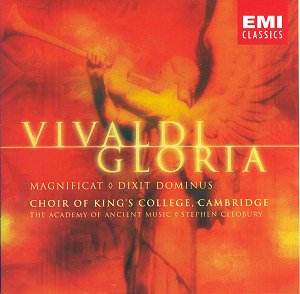It is the Gloria of course, which grabs the headlines
on the front of the CD. It is Vivaldi’s best-known piece of church music.
The Gloria falls into eleven sections of similarly short length with
attractive and arresting ideas, which are easy to remember. The work
as a whole is not at all difficult for any decent amateur choir. There
are also solo sections like the ‘Domine Deus, Rex Coelestis’ and duets
like the ‘Laudamus te’ sung here with sheer delight by the two named
sopranos. The ‘Domine Deus filius patris’ features the wonderfully expressive
Michael Chance. Most choral societies will have tackled the piece and
collectors and general music lovers will want a version at home. So
is this a good choice?
Well it all depends on whether you like boys on the
top part or women or if you like original instruments as you have here.
If you are not at all bothered then perhaps the excellent Naxos version
performed by the Schola Cantorum of Oxford and the Northern Chamber
Orchestra (8.550767) coupled with the wonderful ‘Beatus Vir’ is for
you, after all why pay full price, unless of course this particular
coupling appeals to you. The Naxos version follows the standard edition
- the one made by Casella for Ricordi. Its good to know here that the
version used is a more recent one by Paul Everett for O.U.P. It is worth
noting that almost every movement has at least a few bars alteration
from the Ricordi version.
The Magnificat (an early work from about 1715) is another
multi-movement work, which should be better known. Of note is the way
Vivaldi involves the orchestra in depicting the scattering of the proud.
This is done with some frenzy. The opening chorus with its powerful
chords is "highly charged and chromatic" to quote the booklet
notes by Simon Heighes. This makes a dramatic contrast with the following
operatic soprano solo ‘Et exultavit’. This movement is for three soloists
including the fine voiced James Gilchrist but also has the choral interjections
- appropriately for the word ‘omnes’.
Vivaldi’s ‘Dixit Dominus’ is the grandest of the settings
on this CD and dates from the period 1720-30. It is a very fine work.
Vivaldi gave up the priesthood, for whatever reason, to work at the
‘ospedale de la pieta’ a girl’s convent school for whom he wrote music,
choral and instrumental. This work has real bass parts which not even
Vivaldi’s versatile girls could have managed. The movement ‘Dominus
ad dextris tuis’ is for tenor and bass. It is very imposingly sung by
James Gilchrist and a fine bass new to me, Jonathan Lemalu. The work
was written for the convent church of St. Lorenzo and is particularly
ambitious. The Handelian opening, full of strong fanfare ideas played
on trumpets, marks the piece off as being different. The homophonic
chordal writing which succeeds it is powerful. The trumpets return with
fanfares in no uncertain terms for the orchestral introduction to movement
7 ‘Judacabit in nationibus’ (He shall judge the heathen). Did Vivaldi
really expect trumpet glissandi? The trumpets appear again for the Gloria.
In contrast the following aria ‘De Torrente in via
bibiet’ (He shall drink of the brook in the way) flows with triplets
in mouth-watering sequences. Sarah Fox here seems ideal deploying perfect
control in the long phrases and sensitive to the ensemble in general.
There is much in this work to captivate and interest. Its performance
will never disappoint, and EMI have captured the difficult college acoustic
without detriment to the music, but enabling you to sense the building;
something which they did not so successfully achieve in recordings there
twenty years ago.
Gary Higginson


